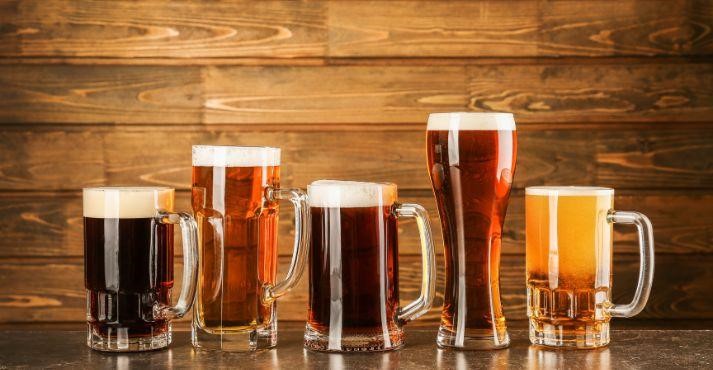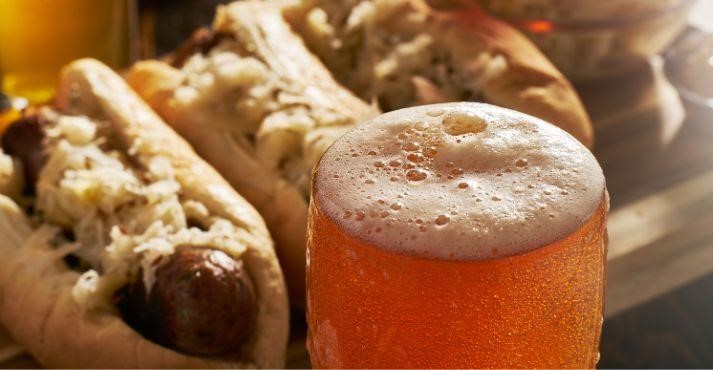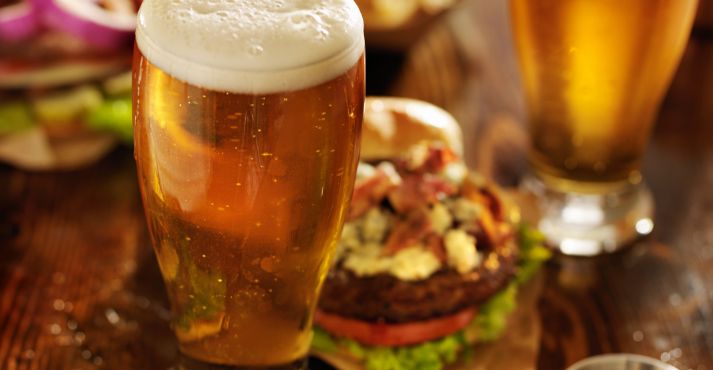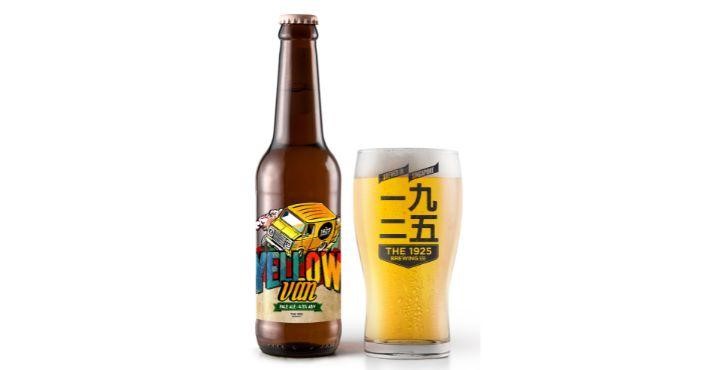The rise of craft beers has significantly changed the beer industry in recent years. With more breweries experimenting with unique flavor profiles, beer lovers have more choices than ever.
In Southeast Asia, the craft beer market has been growing, and an increase of 23% in sales over the next five years is projected as well.
One popular style within the craft beer movement is the Indian Pale Ale (IPA). Known for its bold, hoppy character, IPA has become a favorite among beer enthusiasts who enjoy its intense flavors and aromas.
Whether you’re new to craft beer or a seasoned fan, IPAs offer an exciting and diverse range of tastes that continue to capture the interest of beer drinkers worldwide.
What Does IPA Stand For?
IPA stands for India Pale Ale. But what does IPA mean in beer? The story goes back to the 18th century when British brewers needed a way to preserve beer for long trips to India.
The journey from Britain to India was hot and long, and the beer needed to stay fresh. Brewers found that adding more hops, which act as a natural preservative, could keep the beer from spoiling during the trip. This beer became known as India Pale Ale or IPA.
The extra hops helped preserve the beer and gave it a strong, hoppy flavor that people came to love. Today, the name India Pale Ale reminds us of its origins during the British colonial period in India.
The unique flavor profile created by these additional hops has made IPA one of the most popular styles in the craft beer world.
This beer style has evolved over the years, and now there are many different types of IPAs to enjoy. Whether you’re a fan of the original British IPA or prefer a modern twist, there’s an IPA out there for everyone.
History and Origin of India Pale Ale
The roots of India Pale Ale (IPA) stretch back to the vibrant brewing landscape of 18th-century England, marking the beginning of a captivating journey that would shape the beer’s identity.
18th-century Brewing Evolution
In the 1700s, the brewing landscape in England underwent a significant evolution. Brewers were experimenting with different styles and techniques, laying the groundwork for the India Pale Ale.
IPA’s Role in British Trade
The Trade Connection
The story of IPA is intricately tied to the British trade with India. During this period, beer was a staple for British expatriates in India, but the long sea voyage posed challenges for preservation.
Brewing for Preservation
To overcome the challenges of transportation, brewers began crafting a beer with higher alcohol content and an abundance of hops. This preserved the beer and introduced a unique flavor profile that would distinguish IPA from other styles.
Emergence of a Style
As IPA gained popularity among those traveling to and residing in India, it emerged as a distinct beer style.
Its success was not only in its ability to withstand the rigors of long journeys but also in capturing the palates of beer enthusiasts with its bold and hop-forward characteristics.
Evolution of Beer Styles
Historical Brewing Practices
The evolution of IPA reflects broader changes in historical brewing practices. The willingness of brewers to innovate and adapt to challenges laid the foundation for the diverse and dynamic world of beer styles we know today.
IPA’s Enduring Legacy
While IPA’s original purpose was practicality—ensuring beer survived the journey to India—its enduring legacy lies in its transformation into a celebrated beer style that continues to captivate the taste buds of beer enthusiasts worldwide.
IPA Vocabulary: Common IPA-related Terms

Understanding IPA terminology can help you understand trends in the beer industry and appreciate the distinctions of this popular beer style. Here are some key terms you should know:
1. IBU (International Bitterness Units)
International Bitterness Units (IBU) is a scale used to measure beer’s bitterness. The bitterness comes from the hops, which add a distinct flavor to the beer.
The higher the IBU, the more bitter the beer will taste. Most IPAs have an IBU between 40 and 70, but some can go even higher. If you love bitter flavors, look for beers with a higher IBU.
2. Dry-Hopped
Dry hopping is a process where hops are added late in brewing, usually during fermentation. This technique enhances the beer’s aroma without increasing its bitterness.
Dry-hopped beers often have fruity, solid, floral, or piney scents, making them very aromatic and flavorful. This process is standard in many modern IPAs, including the famous New England IPAs.
3. Single-Hopped
A Single-Hopped IPA is brewed using only one hop variety throughout the brewing process, allowing that hop’s unique characteristics to shine through.
For example, a Citra single-hopped Indian Pale Ale or IPA will exclusively use Citra hops, highlighting its citrusy and tropical fruit flavors. Single-hopped beers are great for tasting and learning about the distinct qualities of different hop varieties.
4. Double or Imperial IPA
A Double IPA or Imperial IPA is a more robust version of the standard IPA. For these IPAs, the alcohol content is higher, usually over 7%, and the hop flavor is more intense. Brewers use more hops and malt, producing more prosperous, robust beer.
These IPAs are often described as “bigger” in flavor and alcohol content. If you enjoy bold, assertive beers, a double or imperial IPA might be for you
5. Juicy vs. West Coast IPAs
Juicy IPAs, often called New England IPAs (NEIPAs), are known for their fruit-forward flavors and hazy appearance. They are less bitter and have a smoother, creamier mouthfeel.
Juicy IPAs are brewed to highlight the fruity and tropical flavors of the hops, making them taste almost like fruit juice. These beers are top-rated among those who prefer less bitterness in their IPAs.
On the other hand, West Coast IPAs are known for their clear appearance and assertive hop bitterness. They have a drier finish, often featuring piney, resinous, and citrusy hop flavors. West Coast IPAs are more traditional and are appreciated for their crisp, clean taste.
6. Haze
The haze in an IPA, especially in New England IPAs, refers to its cloudy appearance. This characteristic cloudiness is due to suspended yeast, proteins, and hop particles in the beer.
Hazy IPAs often have a thicker mouthfeel and can be very aromatic, with intense fruity flavors. The haze is a visual cue that the beer might be juicy and less bitter, appealing to those who enjoy a softer, smoother IPA.
Types of IPA Beer

Now that we know IPA’s meaning, let’s look at its various types, also known as sub-styles, each with unique characteristics and flavors. Let’s explore some of the most popular IPA sub-styles:
1. Pale Ale
A Pale Ale is a traditional beer style known for its balanced flavor. It typically has a moderate amount of hops and malt, giving it a nice blend of bitterness and sweetness.
Pale ales are usually amber and have an alcohol content ranging from 4.5% to 6.2%. They are a great introduction to hoppy beers and have a pleasant, easy-drinking quality.
2. American IPA
American Indian Pale Ale, or America IPA, is a bold and hoppy sub-style of IPA that originated in the United States. This type of IPA emphasizes American hop varieties, often imparting flavors and aromas of citrus, pine, and tropical fruits.
American IPAs typically have a higher IBU, giving them a noticeable bitterness. For this IPA, alcohol content usually ranges from 5.5% to 7.5%. American IPAs are very popular in craft beer and are known for their vibrant hop character.
3. New England IPA (NEIPA)
New England IPA (NEIPA) is a sub-style known for its hazy appearance and juicy flavor profile. Unlike traditional IPAs, NEIPAs are brewed with low bitterness and high fruitiness. The haze comes from suspended yeast, proteins, and hop particles in the beer, giving it a thick, cloudy look.
NEIPAs often have aromas and flavors of tropical fruits, like mango, pineapple, and citrus, making them taste almost like fruit juice. They are very smooth and have a creamy mouthfeel. The alcohol percentage for this type of IPA is typically between 6% and 8%.
4. Session IPA
A Session IPA is designed to be a lighter, more drinkable version of a traditional IPA. With a lower alcohol content, usually below 5%, Session IPAs allow you to enjoy the hoppy flavors without getting too intoxicated.
Session IPAs have a thinner body and less bitterness than other IPAs, making them perfect for extended drinking sessions. They are great for those who want to enjoy the taste of an IPA without the high alcohol content.
5. West Coast IPA
West Coast IPA is a classic sub-style known for its unmistakable appearance and assertive hop bitterness. These IPAs are brewed with a focus on American hops, which provide flavors and aromas of pine, citrus, and resin.
West Coast IPAs have a dry finish and higher beer carbonation, which gives them a crisp and refreshing taste. The IPA’s alcohol content typically ranges from 6% to 8%. This sub-style is appreciated for its bold flavors and clean taste, making it a favorite among traditional IPA lovers.
6. Oat IPA
An Oat IPA is a unique sub-style incorporating oats into brewing. The addition of oats gives the beer a smooth and creamy mouthfeel.
Oat IPAs often have a hazy appearance, similar to NEIPAs, but with a softer texture. The flavors can range from fruity to earthy, depending on the hops used. The alcohol content is usually between 5% and 7.5%. Oat IPAs are perfect for those who enjoy a rich, silky beer with a balanced hop profile.
Flavor Profile of IPA Beer
India Pale Ale (IPA) is renowned for its bold and complex flavor profile, making it a standout among other beer styles. Every aspect of an IPA contributes to its unique and memorable taste experience, from its distinctive bitterness to its diverse aromas and flavors. Let’s dive into the key elements that define the flavor profile of IPA beer.
1. Hops and Bitterness
Hops play a crucial role in defining the flavor profile of India Pale Ale (IPA), especially its characteristic bitterness. Hops are the flowers of the hop plant, Humulus lupulus, and they contain alpha acids responsible for beer’s bitterness.
When hops are boiled during brewing, these alpha acids are released and undergo a chemical transformation that increases their bitterness. This bitterness is essential in balancing the sweetness of the malt, creating a more complex and enjoyable beer.
The degree of bitterness in an IPA is measured in International Bitterness Units (IBU). Higher IBU values indicate a more bitter beer. For example, a typical IPA might have an IBU range of 40 to 70, but some IPAs can have an IBU of over 100.
The choice and combination of hop varieties also contribute to the unique bitterness of each Indian Pale Ale, with different hops imparting varying levels of bitterness and flavor.
2. Aromas and Flavors
One of the most exciting aspects of IPAs is their rich and diverse aromas and flavors. These sensory experiences are primarily derived from the essential oils in hops, which include myrcene, humulene, and caryophyllene. Each hop variety has its unique oil composition, leading to various potential aromas and flavors.
- Citrus: Many IPAs have intense citrus aromas and flavors reminiscent of grapefruit, lemon, and orange. Hops like Cascade and Citra are known for their citrusy notes.
- Pine: Piney aromas and flavors are another common characteristic of IPAs, especially those using Chinook or Simcoe hops. This can give the beer a fresh, resinous quality.
- Floral: Some hops, such as Centennial and Amarillo, impart floral aromas and flavors, adding a delicate and fragrant touch to the beer.
- Tropical Fruits: Hops like Mosaic and Galaxy bring tropical fruit flavors to IPAs, including notes of mango, pineapple, and passion fruit. These flavors are particularly prominent in New England IPAs (NEIPAs).
- Herbal and Spicy: Certain hops can also contribute herbal and spicy notes, such as Saaz’s earthy and peppery flavors or East Kent Goldings hops.
3. Mouthfeel and Finish
The mouthfeel and finish of an IPA can vary greatly depending on the brewing techniques and ingredients used. However, there are some common characteristics that many IPAs share.
- Mouthfeel: IPAs generally have a medium to full-bodied mouthfeel. The presence of hops and higher carbonation levels contribute to a lively and sometimes prickly sensation on the palate. New England IPAs often have a smoother and creamier mouthfeel, achieved by adding oats and wheat to the brewing process.
- Finish: An IPA’s finish is typically dry and crisp, leaving a lingering bitterness on the palate. This dry finish results from the hops and the beer’s higher attenuation, meaning more sugars have been converted to alcohol, leaving less residual sweetness. The bitterness can range from moderate to intense, depending on the style of IPA.
Food Pairing with India Pale Ale

India Pale Ale (IPA) offers a vibrant palette of hop-forward and robust flavors, making it a versatile companion for a wide range of culinary delights. Let’s explore the diverse possibilities of food pairing with IPA, unlocking the harmony between beer and cuisine.
Culinary Complementarity with Hop-forward Beers
Hop-forward Flavors
The hop-forward flavors of IPA create a unique synergy with various dishes. The pronounced bitterness, citrusy notes, and floral aromas enhance the overall dining experience, making IPA an excellent choice for those seeking a culinary adventure.
Pairing Beer with Spicy Food
IPA’s bold and hoppy profile makes it an ideal companion for spicy cuisines. The beer’s bitterness and hop character cut through the heat, providing a refreshing contrast that elevates the flavors of dishes such as spicy curries, tacos, or hot wings.
IPA and Savory Dishes
The robustness of IPA also complements rich and savory dishes. Whether it’s a hearty burger, grilled meats, or flavorful stews, the malt-hop balance in IPA harmonizes with the savory elements, creating a delightful interplay of flavors.
Culinary Harmony with IPA
Diverse Food Pairing Possibilities
The culinary harmony with IPA extends to a diverse array of foods. From zesty salads to tangy seafood, the beer’s versatility enhances the flavors of light and bold dishes, making it a favorite choice for food enthusiasts.
Elevating the Dining Experience
Choosing IPA as a pairing partner elevates the dining experience, bringing out the best in beer and food. The interplay of hop bitterness, aromatics, and malt sweetness adds complexity to the overall flavor profile, creating a memorable and satisfying combination.
Popular IPA Brands and Recommendations

Regarding India Pale Ale (IPA), numerous brands and breweries worldwide have perfected this popular beer style. Whether you’re exploring global giants, local favorites, or renowned craft breweries, there’s an IPA for every palate. Here are some top recommendations to consider:
Global Brands
Some well-known IPA brands from around the world include:
- Sierra Nevada (United States) – Famous for its Torpedo Extra IPA, also known for its bold hop flavors.
- BrewDog (Scotland) – Renowned for Punk IPA, it perfectly balances tropical fruit and bitterness.
- Stone Brewing (United States) – Celebrated for Stone IPA, a classic example of a West Coast IPA with intense citrus and pine notes.
Local Favorites
In Southeast Asia, several IPA brands have gained popularity:
- The 1925 Brewing Co. (Singapore) – Known for its signature Yellow Van IPA, offering a delightful blend of citrus and pine flavors.
- Heart of Darkness Brewery (Vietnam) – Famous for its Kurtz’s Insane IPA, a robust and flavorful brew with a tropical fruit profile.
- Beervana (Thailand) – Recognized for its Full Moon Chalawan Pale Ale, which combines local ingredients with traditional IPA bitterness.
Craft Breweries
Notable craft breweries known for their exceptional Indian Pale Ale offerings include:
- Dogfish Head Brewery (United States) – Known for its 90-minute IPA, a well-balanced beer with a complex hop profile.
- Lagunitas Brewing Company (United States) – Famous for its Lagunitas IPA, a smooth and highly drinkable option with a citrusy hop character.
Trillium Brewing Company (United States) – Renowned for its Congress Street IPA, a hazy and juicy New England IPA with tropical fruit notes.
Conclusion
Wrapping up our exploration of India Pale Ale (IPA), key takeaways spotlight its unique beer characteristics and historical roots.
The diverse sub-styles within IPA showcase its adaptability, contributing to its central role in the craft brewing movement.
As we conclude, it’s evident that IPA’s legacy in craft beer is firmly established, and its future remains dynamic, promising continued impact and innovation in the ever-evolving landscape of brewing culture.
Craft beer’s IPA legacy endures, paving the way for the continued exploration and evolution of this iconic beer style in the future of brewing.













